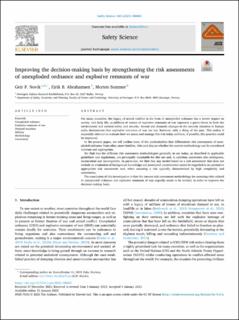| dc.contributor.author | Novik, Geir Petter | |
| dc.contributor.author | Abrahamsen, Eirik Bjorheim | |
| dc.contributor.author | Sommer, Morten | |
| dc.date.accessioned | 2023-08-24T13:33:37Z | |
| dc.date.available | 2023-08-24T13:33:37Z | |
| dc.date.created | 2023-04-13T08:25:34Z | |
| dc.date.issued | 2023-04 | |
| dc.identifier.citation | Novik, G.P., Abrahamsen, E.B., Sommer, M. (2023) Improving the decision-making basis by strengthening the risk assessments of unexploded ordnance and explosive remnants of war. Safety Science, 160, 106065 | en_US |
| dc.identifier.issn | 0925-7535 | |
| dc.identifier.uri | https://hdl.handle.net/11250/3085688 | |
| dc.description.abstract | For many countries, the legacy of armed conflict in the form of unexploded ordnance has a severe impact on society and daily life, as millions of tonnes of explosive remnants of war represent a grave threat to both the environment and societal safety and security. Recent and dramatic changes in the security situation in Europe sadly demonstrate that explosive remnants of war are not, however, only a thing of the past. This makes it especially relevant to evaluate how we assess and manage this risk today and how, if possible, this practice could be improved.
In the present paper, we will outline some of the particularities that differentiate risk assessments of unexploded ordnance from other, more familiar, risks and discuss whether the current methodology can be considered relevant and appropriate.
We find that the different risk assessment methodologies generally in use today, as described in applicable guidelines and regulations, are principally unsuitable for this use and, in addition, sometimes also ambiguous, inconsistent and incompatible. In particular, we find that any model based on a risk assessment that does not include an evaluation of background knowledge and associated uncertainties cannot be regarded as an optimal or appropriate risk assessment tool, when assessing a risk typically characterized by high complexity and uncertainty.
The conclusion of this investigation is that the current risk assessment methodology for assessing risks related to unexploded ordnance and explosive remnants of war urgently needs to be revised, in order to improve the decision-making basis. | en_US |
| dc.language.iso | eng | en_US |
| dc.publisher | Elsevier Ltd. | en_US |
| dc.rights | Navngivelse 4.0 Internasjonal | * |
| dc.rights.uri | http://creativecommons.org/licenses/by/4.0/deed.no | * |
| dc.subject | krigsrester | en_US |
| dc.subject | sikkerhet | en_US |
| dc.subject | samfunnssikkerhet | en_US |
| dc.subject | beslutningstagelse | en_US |
| dc.subject | beslutningstaking | en_US |
| dc.title | Improving the decision-making basis by strengthening the risk assessments of unexploded ordnance and explosive remnants of war | en_US |
| dc.type | Peer reviewed | en_US |
| dc.type | Journal article | en_US |
| dc.description.version | publishedVersion | en_US |
| dc.rights.holder | © 2023 The Authors. | en_US |
| dc.subject.nsi | VDP::Samfunnsvitenskap: 200 | en_US |
| dc.source.volume | 160 | en_US |
| dc.source.journal | Safety Science | en_US |
| dc.identifier.doi | 10.1016/j.ssci.2023.106065 | |
| dc.identifier.cristin | 2140447 | |
| dc.source.articlenumber | 106065 | en_US |
| cristin.ispublished | true | |
| cristin.fulltext | original | |
| cristin.qualitycode | 2 | |

